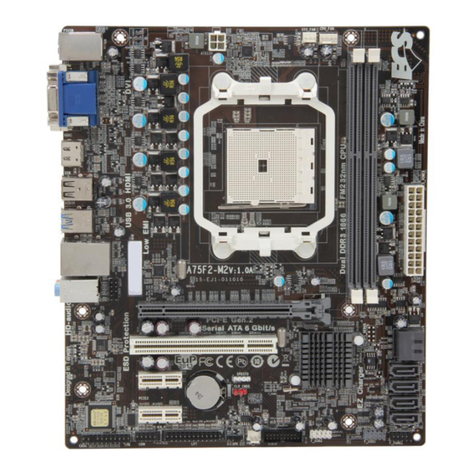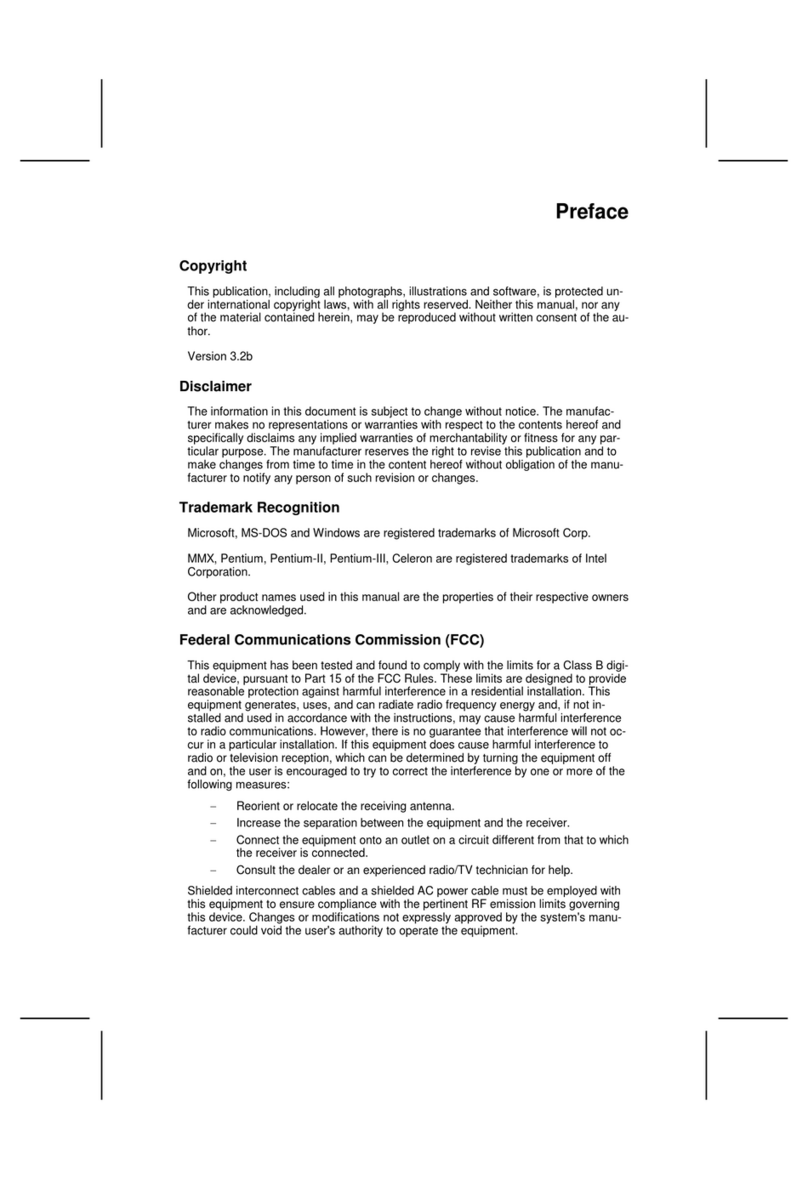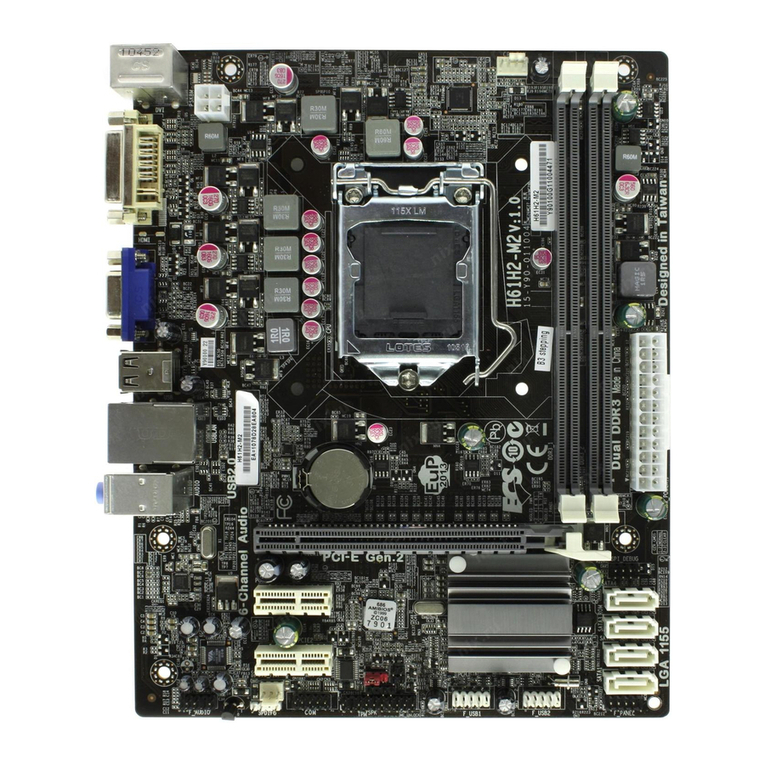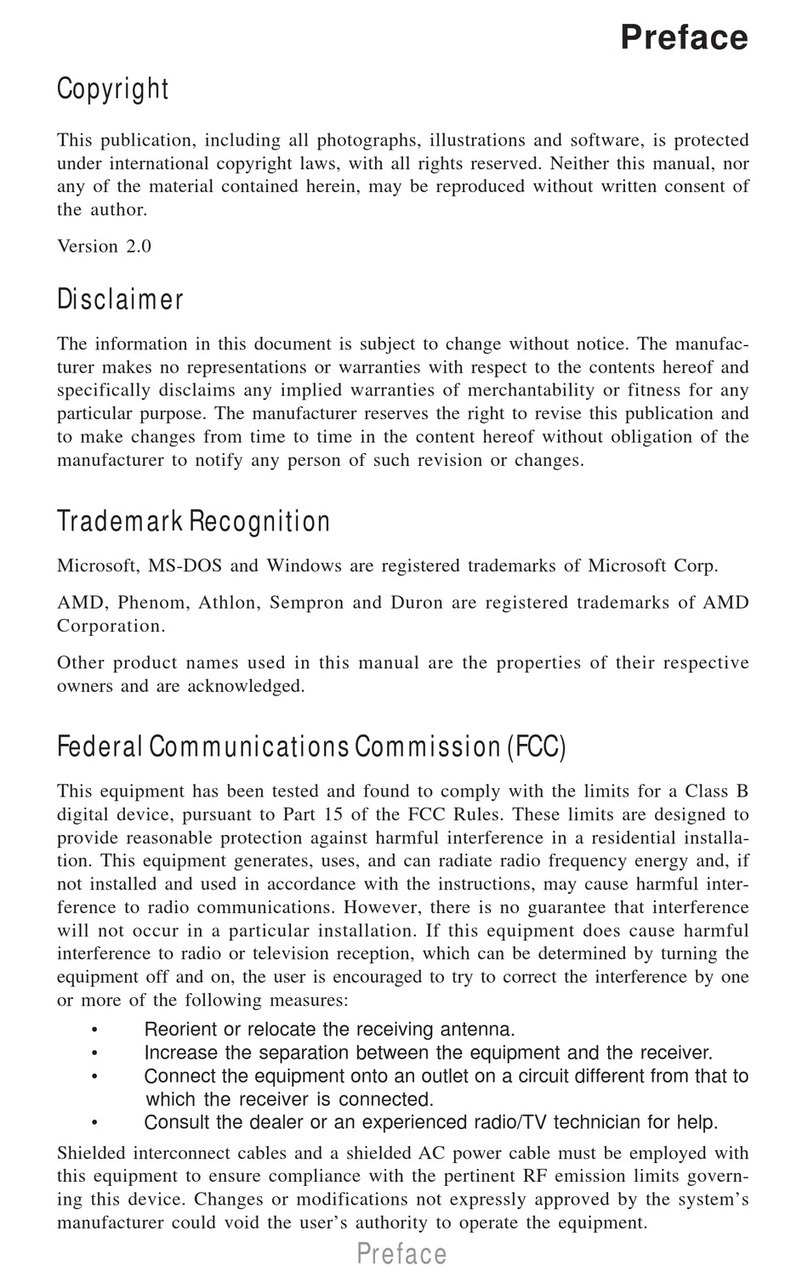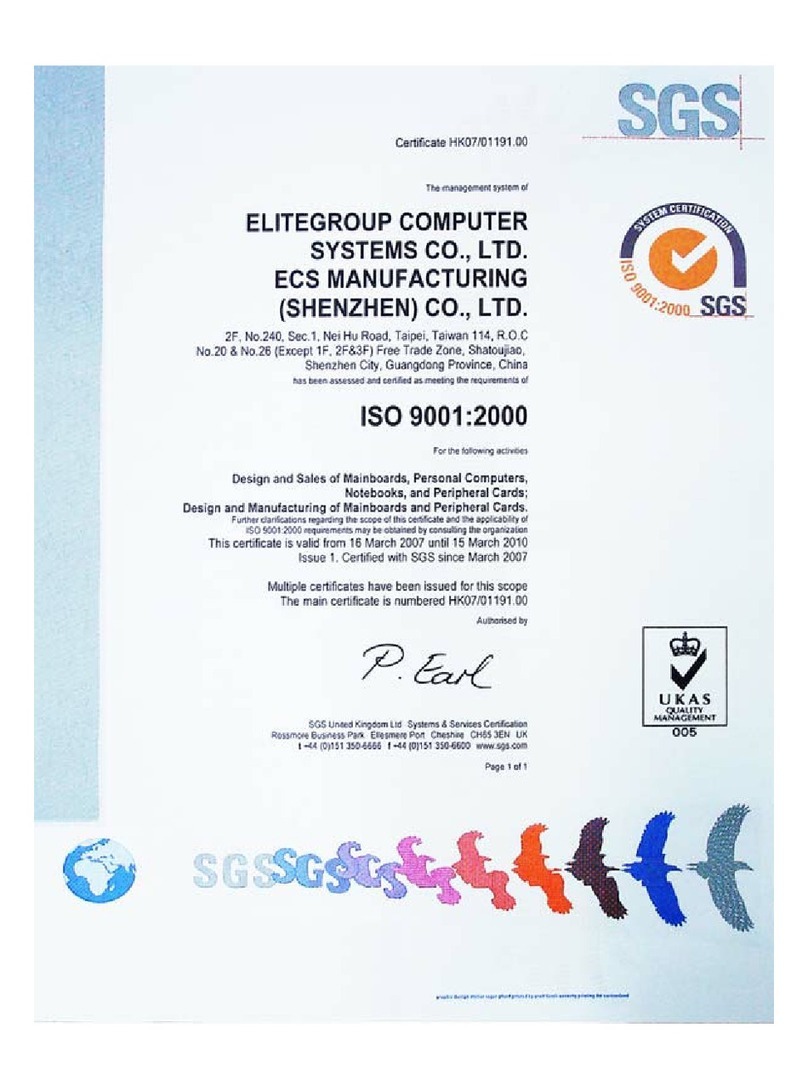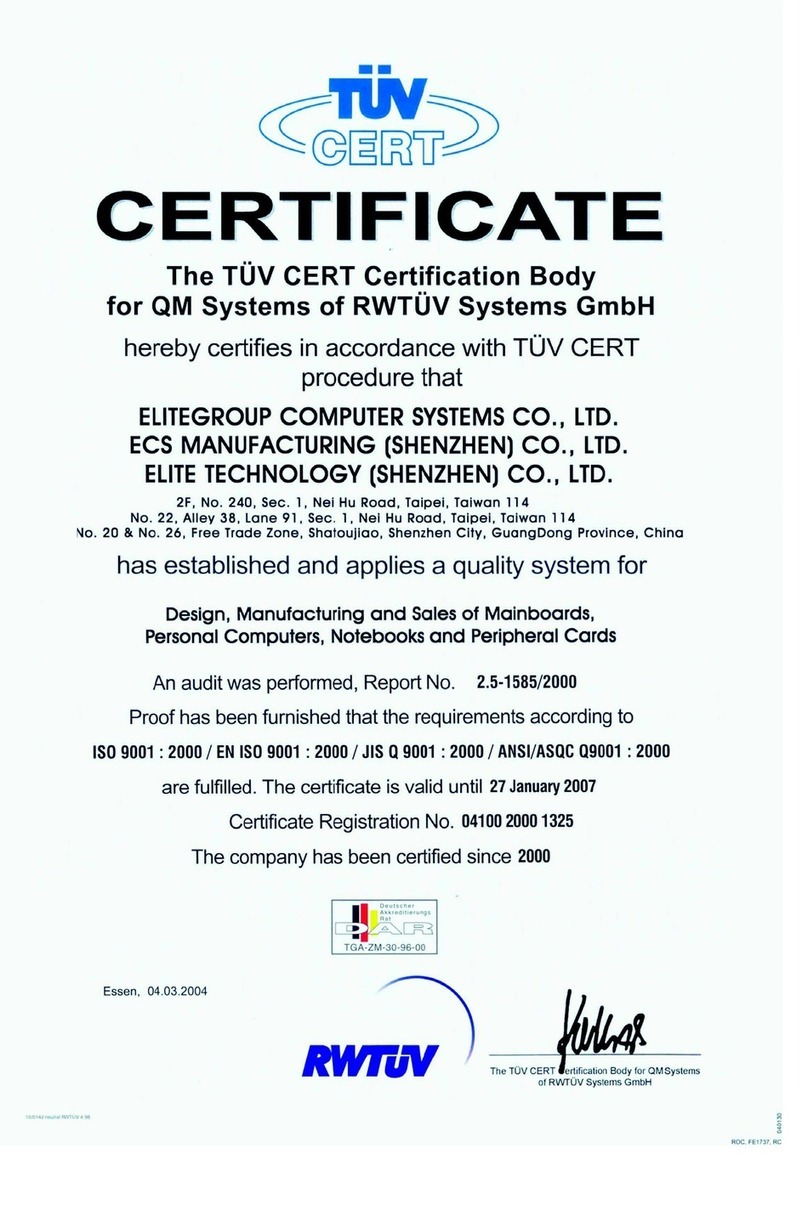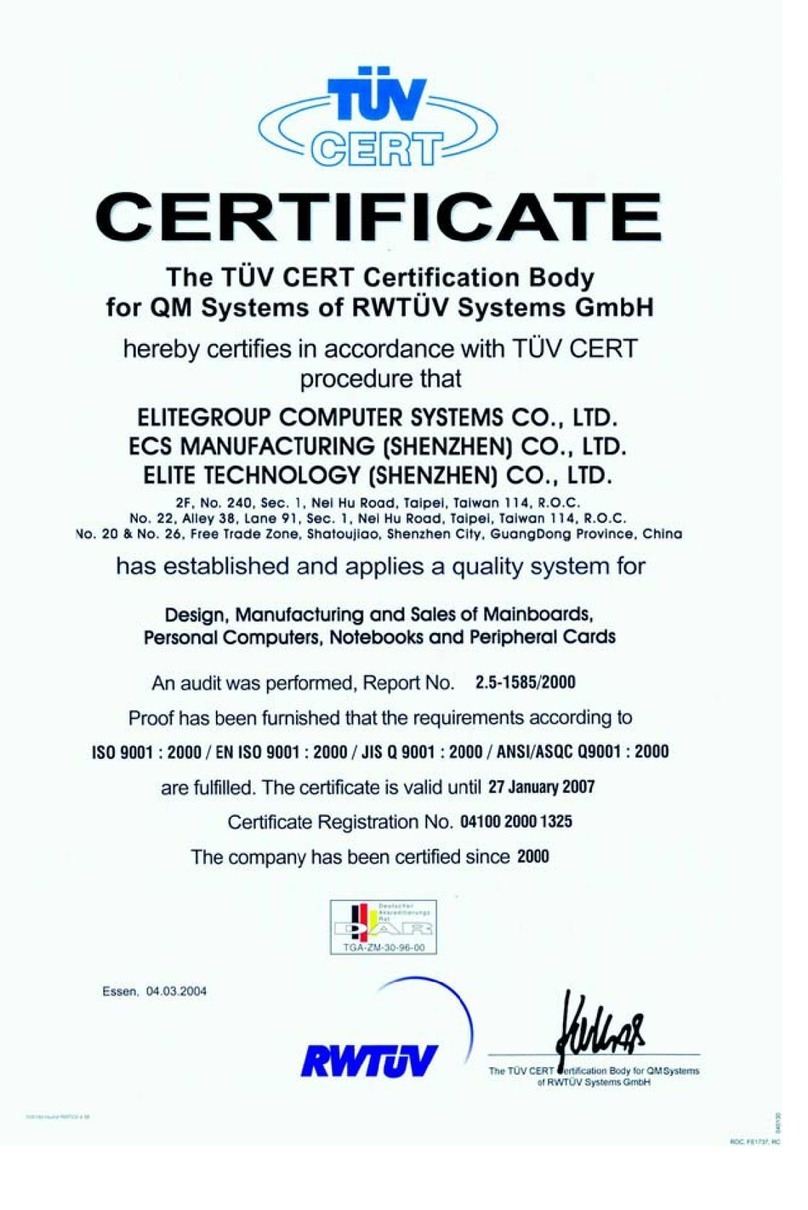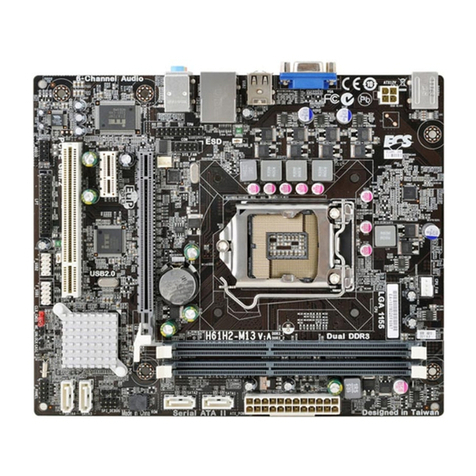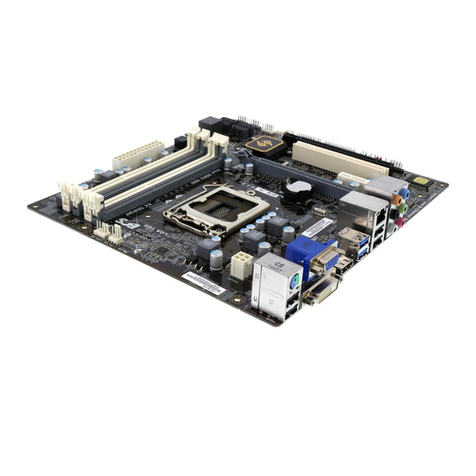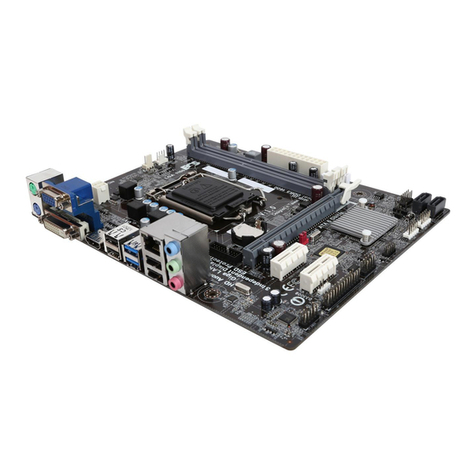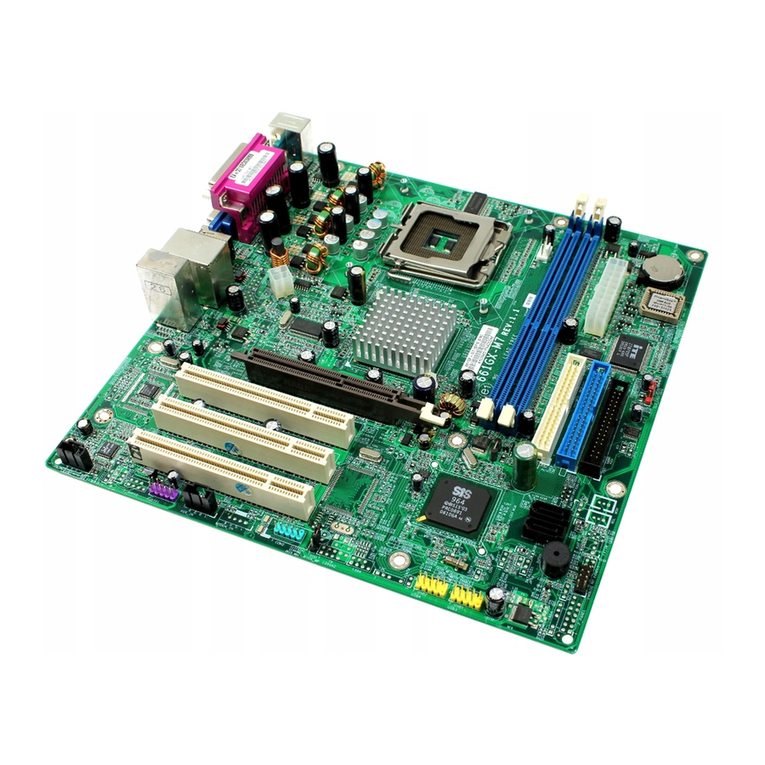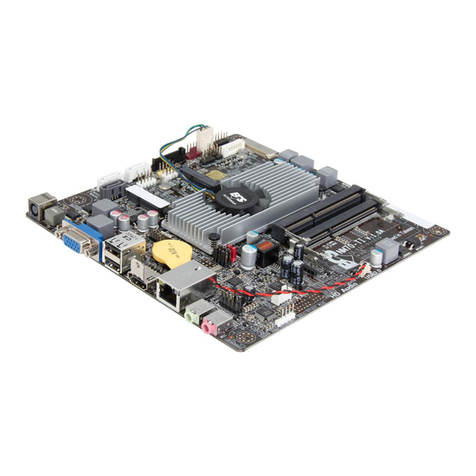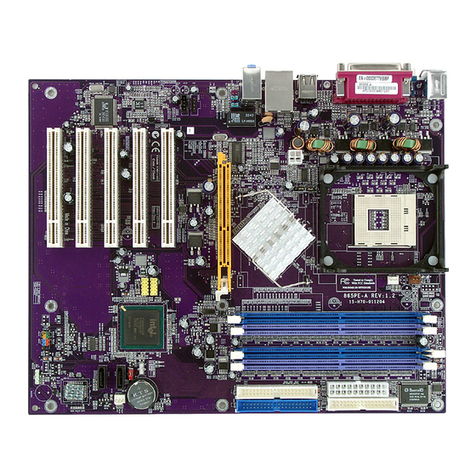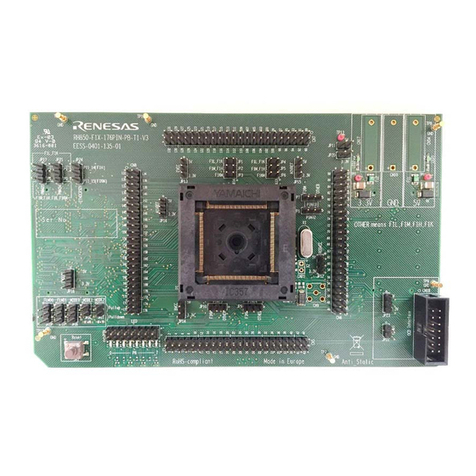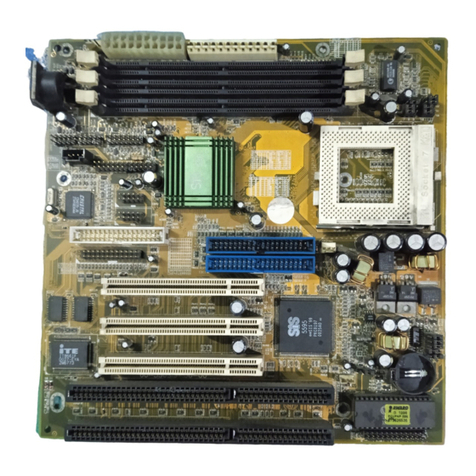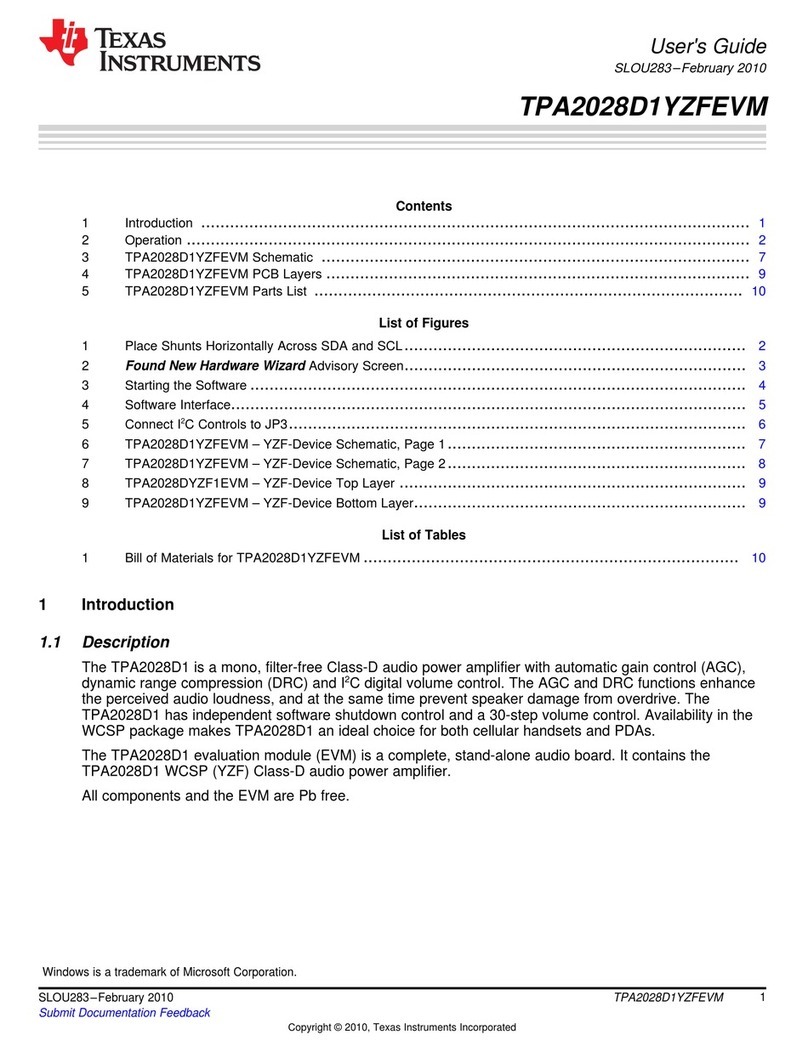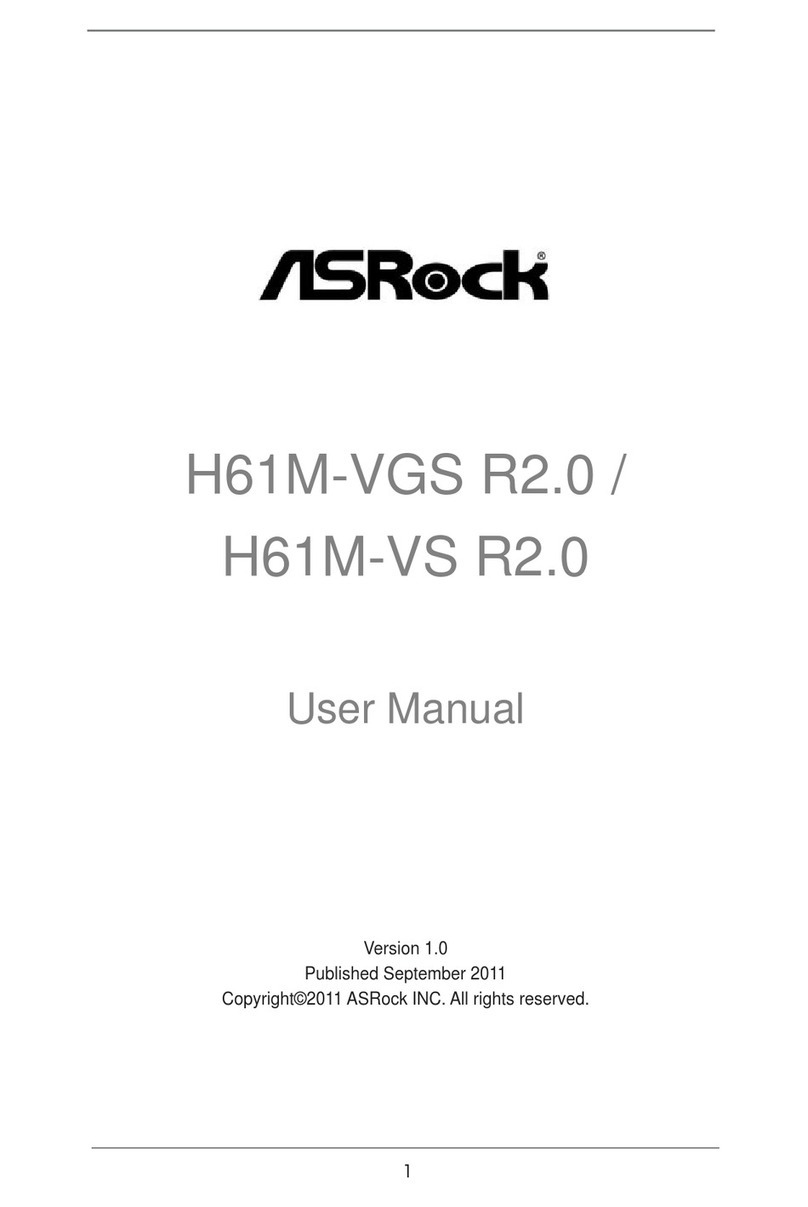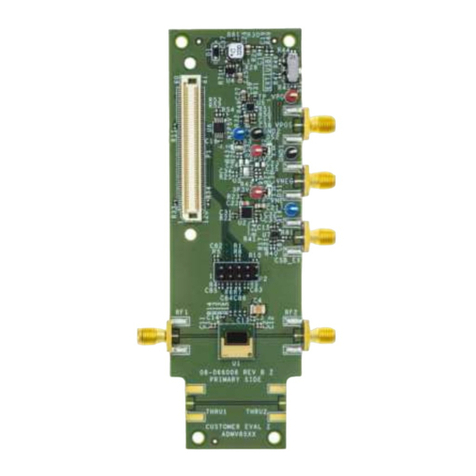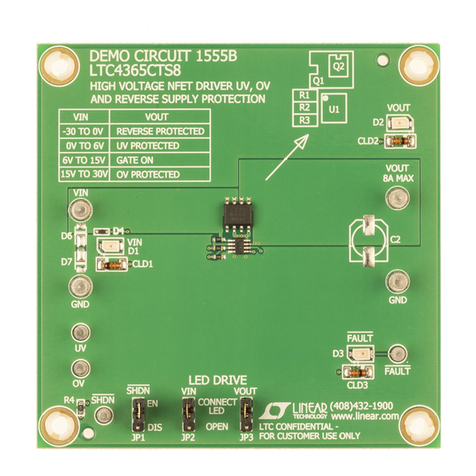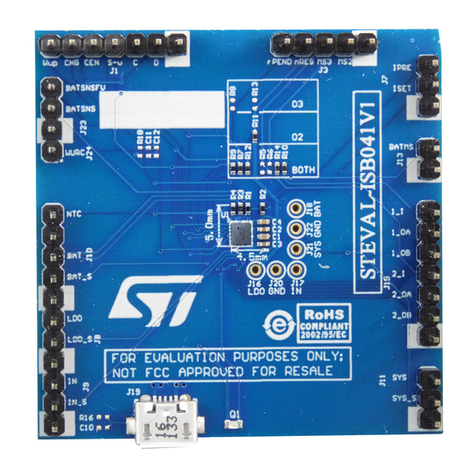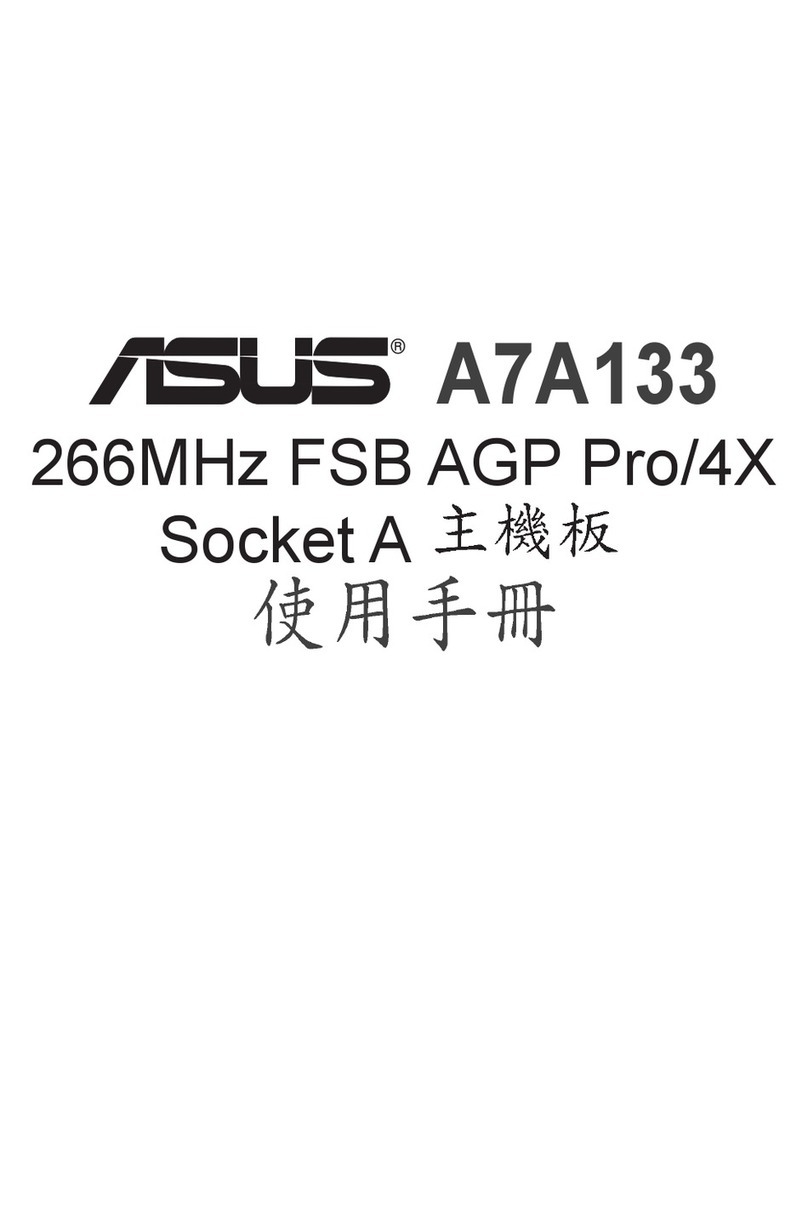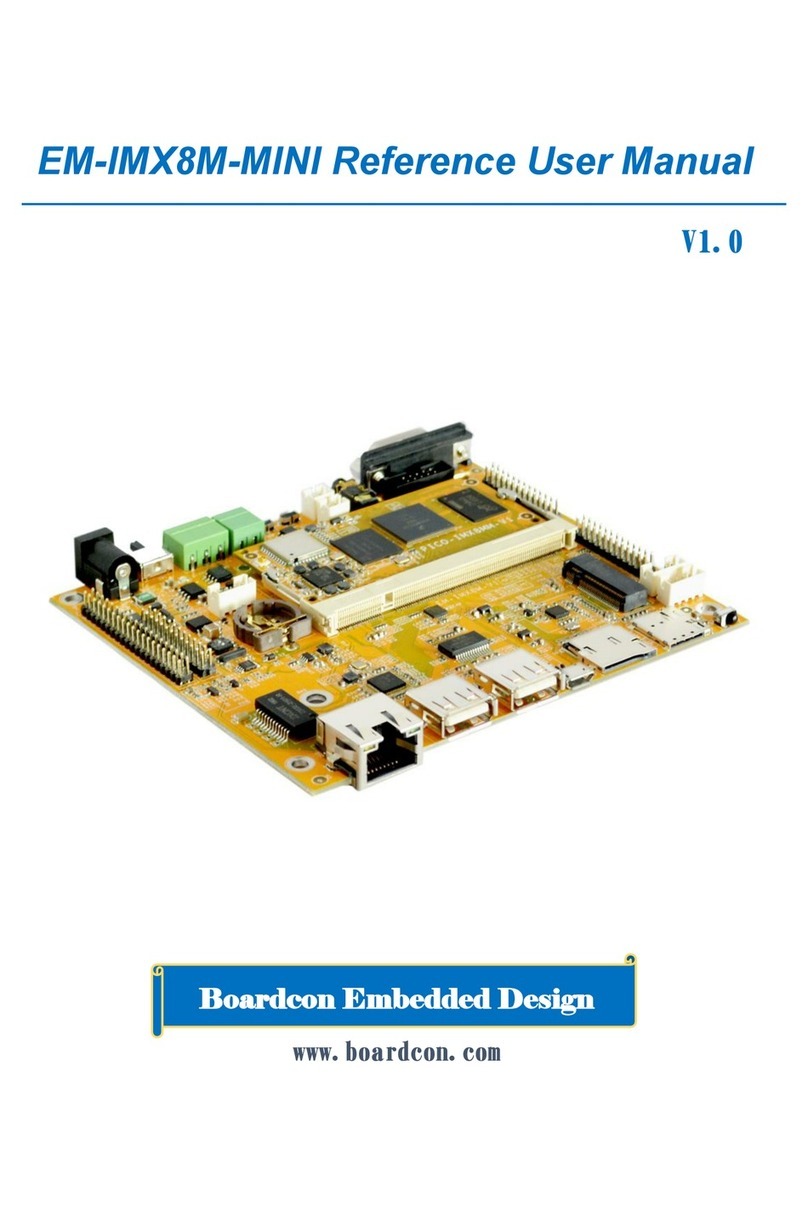ECS K7VTA3 User manual

Preface
Copyright
This publication, including all photographs, illustrations and software, is protected un-
der international copyright laws, with all rights reserved. Neither this manual, nor any
of the material contained herein, may be reproduced without written consent of the au-
thor.
Version 6.0c
Disclaimer
The information in this document is subject to change without notice. The manufac-
turer makes no representations or warranties with respect to the contents hereof and
specifically disclaims any implied warranties of merchantability or fitness for any par-
ticular purpose. The manufacturer reserves the right to revise this publication and to
make changes from time to time in the content hereof without obligation of the manu-
facturer to notify any person of such revision or changes.
Trademark Recognition
Microsoft, MS-DOS and Windows are registered trademarks of Microsoft Corp.
MMX, Pentium, Pentium-II, Pentium-III, Celeron are registered trademarks of Intel
Corporation.
Other product names used in this manual are the properties of their respective owners
and are acknowledged.
Federal Communications Commission (FCC)
This equipment has been tested and found to comply with the limits for a Class B digi-
tal device, pursuant to Part 15 of the FCC Rules. These limits are designed to provide
reasonable protection against harmful interference in a residential installation. This
equipment generates, uses, and can radiate radio frequency energy and, if not in-
stalled and used in accordance with the instructions, may cause harmful interference
to radio communications. However, there is no guarantee that interference will not oc-
cur in a particular installation. If this equipment does cause harmful interference to
radio or television reception, which can be determined by turning the equipment off
and on, the user is encouraged to try to correct the interference by one or more of the
following measures:
−Reorient or relocate the receiving antenna.
−Increase the separation between the equipment and the receiver.
−Connect the equipment onto an outlet on a circuit different from that to which
the receiver is connected.
−Consult the dealer or an experienced radio/TV technician for help.
Shielded interconnect cables and a shielded AC power cable must be employed with
this equipment to ensure compliance with the pertinent RF emission limits governing
this device. Changes or modifications not expressly approved by the system's manu-
facturer could void the user's authority to operate the equipment.

ii
Declaration of Conformity
This device complies with part 15 of the FCC rules. Operation is subject to the follow-
ing conditions:
−This device may not cause harmful interference, and
−This device must accept any interference received, including interference
that may cause undesired operation.
Canadian Department of Communications
This class B digital apparatus meets all requirements of the Canadian Interference-
causing Equipment Regulations.
Cet appareil numérique de la classe B respecte toutes les exigences du Réglement
sur le matériel brouilieur du Canada.
About the Manual
The manual consists of the following:
Chapter 1
Introducing the Motherboard
Describes features of the motherboard,
and provides a shipping checklist.
Go to ⇒page 1
Chapter 2
Installing the Motherboard
Describes installation of motherboard
components.
Go to ⇒page 6
Chapter 3
Using BIOS
Provides information on using the BIOS
Setup Utility.
Go to ⇒page 22
Chapter 4
Using the Motherboard Software
Describes the motherboard software.
Go to ⇒page 47

iii
Features Translations
Caractéristiques
Processeur La carte mère utilise un Socket A AMD 462 broches présen-
tant les caractéristiques suivantes:
•Supporte un bus frontal (FSB) de 333/266/200 MHz
•Peut recevoir les CPU AMD Athlon XP/Sempron/Athlon
/Duron avec FSB jusqu'à 333 MHz
Chipset Le chipset sur K7VTA3 comprend le KT333CE Northbridge et
VT8235 Southbridge basés sur une architecturenovatriceet
dimensionnable avec une fiabilité et des performances prouvées.
Quelques-unes des caractéristiques avancées des chipsets sont:
•Prend en charge les CPU AMD Athlon XP/Sempron/
Athlon/Duron avec FSB jusqu'à 333 MHz
•Contrôleur système Athlon à simple puce avec CPU
Athlon Socket-462 64 bits, mémoire système DDR 64 bits
100/133/166 MHz, NB/SB V-Link à haute bande pas-
sante 266 Mo/sec et interfaces AGP 32 bits
•Conforme AGP v2.0
•Interface DRAM synchrone avec CPU d’hôte
(100/133/166 MHz) pour une configuration plus flexible
•Supporte une interface Client V-Link 66 MHz avec une
bande passante de pointe de 266 Mo/sec
•File d’attente de transaction particulière configurable pour
accès Clients V-Link
•Contrôleur Fast Ethernet intégré avec capacités 1/10/100
Mbits
•Contrôleur USB 2.0 intégré avec trois hubs racine et six
ports de fonction
•Contrôleur EIDE de mode maître Ultra DMA 33/66/100/
133 de Canal double
•Supporte jusqu’à cinq maîtres PCI
•2 K octets indépendants de FIFO pour recevoir et trans-
mettre
•Compatible USB v2.0 et Interface de Contrôleur d’Hôte
Universel (UHCI) v2.0
•Supporte à la fois ACPI v1.0 et APM v1.2 hérité
•Accélération d’horloge de CPU et contrôle d’arrêt de bus
d’horloge pour support d’état ACPI C0 à C3 complet
•Interruptions orientables pour contrôleurs de périphérique
intégrés : USB, lecteur de disquette, série, parallèle et
audio
Graphiques La carte mère comprend un logement AGP qui offre quatre fois
la bande passante des spécifications AGP d’origine. La technolo-
gie AGP offre une connexion directe entre le sous-système
graphique et le processeur de sorte que les graphiques n’ont pas
à entrer en concurrence avec d’autres périphériques pour le temps
d’utilisation du processeur sur le bus PCI.
Mémoire •Peut recevoir deux logements sans mémoire tampon en
2.5V de 184 broches
•Supporte les vitesses de mémoire suivantes : DDR
SDRAM: PC2700/ PC2100/PC1600

iv
•Chaque logement supporte jusqu’à 1 Go avec une capa-
cité maximum totale de 2 Go
Audio Le Codec Audio VIA VT1612A est conforme aux spécifications
AC'97 2.2 offrant des performances de résolution en 18 bits.
Avec des sorties à 2 canaux la VIA VT1612A offre une qualité
stéréo de hautes performances pour connexions d’écouteurs
et de haut-parleurs.
•Codec conforme à l’extension AC’97 2.2 S/PDIF
•Stéréo 18 bits full duplex
•Extension stéréo 3D pour contour simulé
•Entrées de niveau de ligne analogique, 2 stéréo, 2 mono
LAN Interne (op-
tionnel) Le VT6103 est un périphérique à Couche Physique pour
Ethernet 10BASE-T et 100BASE-TX utilisant des câbles Non
blindés de catégorie 5 et Blindés de Type 1.
•Double Vitesse – 100/10 Mbps
•Half et Full Duplex
•Conforme à tous les Standards IEEE 802.3, 10Base-T et
100Base-Tx Applicables
•Egaliseur Adaptatif
E/S Intégrée La carte mère possède un jeu complet de ports d’E/S et de
connecteurs:
•Deux ports PS/2 pour souris et clavier
•Un ports série
•Un port parallèle
•Quatre ports USB
•Un port LAN (optionnel)
•Prises audio pour microphone, ligne d’entrée et ligne de
sortie
Microprogramme
BIOS Cette carte mère utilise Award BIOS qui permet aux utilisa-
teurs de configurer de nombreuses caractéristiques du
système comprenant les suivantes:
•Gestion d’alimentation
•Alarmes de réveil
•Paramètres de CPU
•Synchronisation de CPU et de mémoire
Le microprogramme peut aussi être utilisé pour définir les
paramètres pour les vitesses d’horloges de différents proces-
seurs.
Certaines spécifications matérielles et éléments de logiciels peuvent être
modifiés sans avertissement.

v
Features
Prozessor Das Mainboard verwendet einen AMD 462-Pin Sockel A mit
den folgenden Eigenschaften:
•Unterstützt 333/266/200 MHz Frontsidebus (FSB)
•Enthält AMD Athlon XP/Sempron/Athlon/Duron CPU mit
FSB bis zu 333 MHz
Chipsatz Der Chipsatz des K7VTA3 enthält eine KT333CE Northbridge und
eineVT8235 Southbridge, dieauf einer innovativen und skalier-
baren Architektur mit bewiesener Zuverlässigkeit und Leistung
basieren. Einige der modernen Eigenschaften des Chipsatzes:
•Unterstützt AMD Athlon XP/Sempron/Athlon/Duron CPU
mit FSB bis zu 333 MHz
•Single-Chip Athlon-System-Controller mit 64-Bit Socket-
462 Athlon CPU, 64-Bit 100/133/166 MHz DDR-
Systemspeicher, V-Link NB/SB-Interfaces mit einer
Bandbreite von bis zu 266 MB/Sek. und 32-Bit AGP-
Interfaces
•Kompatibel mit AGP v2.0
•Das DRAM-Interface ist für flexible Konfiguration syn-
chron zur Host-CPU (100/133/166 MHz)
•Unterstützung für 66 MHz V-Link Client Interface mit einer
Spitzen-Bandbreite von 266 MB/Sek.
•Konfigurierbare “Outstanding Transaction-Queue” für V-
Link Client-Zugriffe
•Onboard-Fast Ethernet Controller mit 1/10/100 Mbit-
Fähigkeit
•Onboard-USB 2.0 Controller mit drei Root Hubs und
sechs Ports
•Dual-Channel Ultra DMA 33/66/100/133 Master Mode
EIDE-Controller
•Unterstützung für bis zu fünf PCI-Master
•Unabhängiger 2KB FIFO-Speicher zum Empfangen und
Senden
•Kompatibel mit USB v2.0 und Universal Host Controller
Interface (UHCI) v2.0
•Unterstützung für ACPI v1.0 und Legacy APM v1.2
•Prozessor-Frequenzanpassung und “Clock bus stop”-
Kontrolle für vollständige “ACPI C0 to C3”-Unterstützung
•Einstellbare Interrupts für integrierte Peripherie-
Controller: USB, Floppy, Seriell, Parallel und Audio
Grafik Das Motherboard enthält einen AGP-Steckplatz ausgestattet,
der gegenüber der ursprünglichen AGP-Spezifikation über die
vierfache Bandbreite verfügt. Da die AGP-Technologie für eine
direkte Verbindung zwischen dem Grafik-Untersystem und dem
Prozessor sorgt, steht dieses bezüglich des Zugriffs auf den Pro-
zessor nicht in Konkurrenz mit anderen Geräten auf dem PCI-bus.
Speicher •Platz für zwei ungepufferte 2.5V 184-Pin-Slots
•Unterstützt die folgenden Speichergeschwindigkeiten:
DDR SDRAM: PC2700/ PC2100/PC1600
•Jeder Steckplatz unterstützt bis zu 1 GB mit einer
Gesamtkapazität von 2 GB
Audio Der VIA VT1612A Audio Codec entspricht der AC'97 2.2-
Spezifikation für 18-Bit-Auflösung. Mit 2-Kanalausgängen
bietet das VIA VT1612A Hochleistungs-Stereoqualität für

vi
Kopfhörer oder Lautsprecher.
•Codec entspricht AC'97 2.2 S/PDIF-Erweiterung
•18-Bit Stereo-Vollduplex
•3D-Stereoerweiterung für simulierten Surround-Sound
•2 Stereo-, 2 analoge Mono Line-level-Eingänge
Onboard-LAN
(optional)
Das VT6103 ist ein Physical-Layer-Gerät für Ethernet
10BASE-T und 100BASE-TX bei Benutzung von nicht
abgeschirmten Kategorie 5-Kabeln und abgeschirmten Typ 1-
Kabeln.
•Zwei Geschwindigkeiten – 100/10 Mbps/Sek.
•Halb- und Vollduplex
•Entspricht allen geltenden IEEE 802.3, 10Base-T und
100Base-Tx-Standards
•Einstellbarer Equalizer
Onboard-I/O Das Motherboard verfügt über einen kompletten Satz von I/O-
Schnittstellen und Anschlüssen:
•Zwei PS/2-Schnittstellen für Maus und Tastatur
•Eine serielle Schnittstellen
•Eine parallele Schnittstelle
•Vier USB - Schnittstelle
•Eine Eine LAN-Schnittstelle (optional)
•Audiobuchsen für Mikrofon, Line-in und Line-out
BIOS
Firmware Dieses Motherboard verwendet Award BIOS, mit dem
Anwender viele Systemeigenschaften selbst konfigurieren
können, einschließlich der folgenden:
•Energieverwaltung
•Wake-up Alarm
•CPU-Parameter
•CPU- und Speichertiming
Mit der Firmware können auch die Parameter für verschiedene
Prozessortaktgeschwindigkeiten eingestellt werden.
Bestimmte Hardwarespezifikationen und Teile der Softwareausstattung
können ohne weitere Ankündigung abgeändert werden.

vii
Caratteristiche
Processor La scheda madre è dotata di un socket A AMD a 462 pin che
presenta le seguenti caratteristiche:
•Supporta il bus di sistema 333/266/200 MHz frontside
(FSB)
•Compatibile con CPU AMD Athlon XP/Sempron/Athlon/
Duron con FSB fino a 333 MHz
Chipset Il chipset K7VTA3 è composto dai chipset Northbrigde
KT333CE e Southbridge VT8235 basati su un’architettura
innovativa e facilmente espandibile dall’affidabilità e dalle
prestazioni dimostrate. Ecco alcune delle caratteristiche
principali dei chipset:
•Supporto per CPU AMD Athlon XP/Sempron/Athlon/
Duron con FSB fino 333 MHz
•Controllore di sistema Athlon a chip singolo con CPU
Athlon 64-bit Socket-462 Athlon CPU, memoria di
sistema 64-bit 100/133/166 MHz DDR, larghezza di
banda alta 266 MB/sec V-Link NB/SB e interfacce 32-bit
AGP
•Compatibilità AGP v2.0
•Interfaccia DRAM sincrona con CPU host (100/133/166
MHz) per il massimo di flessibilità di configurazione
•Supporta interfaccia client V-link 66 MHz con picco di
larghezza di banda di 266 MB/sec
•Coda transazioni in corso configurabile per gli accessi V-
Link Client
•Controller Fast Ethernet Integrato con capacità pari a
1/10/100 Mbit
•Controller USB 2.0 integrata con tre hub di root e sei
porte funzione
•Controller EIDE a canale doppio Ultra DMA
33/66/100/133 modalità master
•Supporta fino a cinque master PCI
•FIFO 2k indipendenti per la ricezione e trasmissione
•Compatibilità USB v2.0 e Universal Host Controller
Interface (UHCI) v2.0
•Supporta sia ACPI v1.0 che APM v1.2 precedenti
•CPU clock throttling e stop control per il clock del bus per
un supporto completo di ACPI da stato C0 a stato C3
•Interrupt registrabili per le schede di controllo delle
periferiche integrate sul sistema: USB, floppy, seriale,
parallela e audio
Grafica La scheda include uno slot AGPche fornisce quattro volte la
larghezza di banda delle specifiche AGP originarie. La tecnologia
AGP fornisce un collegamento diretto tra il sottosistema grafico e il
processore in modo che la grafica no debba competere con altre
periferiche sul bus PCI per i tempi processore
Memoria •Comprende due slot 2.5V da 184 pin senza buffer
•Supporta le seguenti velocità di memoria: DDR SDRAM:
PC2700/ PC2100/PC1600
•Ogni slot supporta sino ad un 1 GB con una capacità
massima pari a2 G
Audio Il VIA VT1612A Audio Codec è conforme alle specifiche AC'97
2.2 che assicurano prestazioni con una risoluzione a 18 bit.

viii
Grazie alle 2 uscite canale, il VIA VT1612A offre una qualità
stereo di alto livello per le connessioni delle cuffie e degli
altoparlanti.
•Estensione AC'97 2.2 S/PDIF, conforme con Codec,
•stereo full duplex a 18 bit
•Espansione 3D stereo per surround simulato
•2 ingressi stereo, 2 ingressi mono analogici a livello di
•linea
LAN integrata
(opzionale))
La scheda VT6103 è un dispositivo Physical Layer per
Ethernet 10BASE-T e 100BASE-TX che usa cavi della
categoria 5 non schermati e Tipo 1 schermati .
•Dual Speed – 100/10 Mbps
•Half e Full Duplex
•Conforme a tutti gli standard applicabili IEEE 802.3,
10Base-T e 100Base-Tx
•Equalizzatore adattivo
I/O integrati La scheda madre è dotata di un set completo di connettori e
porte I/O:
•Due porte PS/2 per mouse e tastiera
•Una porta seriale
•Una porta parallela
•Quattro porte USB
•Una porta LAN (opzionale)
•Jack audio per microfono e connettori ingresso/uscita
Line
BIOS
Firmware Questa scheda madre utilizza il BIOS Award che permette
all’utente di configurare numerose caratteristiche del sistema
tra cui le seguenti:
•Risparmio energetico
•Segnali Wake Up
•Parametri della CPU e sincronizzazione memoria
•Timing della memoria e della CPU
E’ possibile inoltre impostare i parametri di velocità del clock
del processore su diversi valori.
Alcune specifiche hardware ed elementi software sono soggetti a variazioni
senza preavviso.

ix
Características
Procesador El panel principal usa un AMD 462-pines Enchufe A que tiene
las siguientes características:
•Permite 333/266/200 MHz bus de lado frontal (FSB)
•Acomoda una CPU AMD Athlon XP/Sempron/Athlon/
Duron con FSB hasta 333 MHz
Chipset El panel principal en el K7VTA3 incluye el KT333CE Northbridge y
VT8235 Southbridge los cuales están basados en una innovadora
y escalada estructura la cual provee confiabilidad y rendimiento.
Algunas de las características avanzadas del chipsetson:
•Soporta una CPU AMD Athlon XP/Sempron/Athlon/Duron
con FSB hasta 333 MHz
•Chip individual Athlon sistema controlador con 64-bit
Enchufe -462 Athlon CPU, 64-bit 100/133/166 MHz DDR
sistema de memoria, 266 MB/por segundo ancho de
banda alto V-Link NB/SB e interfases 32-bit AGP
•AGP v2.0 convencional
•Interfaz síncrona DRAM con CPU servidor (100/133/166
MHz) para una configuración más flexible
•Soporta 66 MHz V-Link interfaz Usuario con un máximo
de ancho de banda de 266 MB/por segundo
•Transacción cola configurable excelente para V-Link
accesos de usuario
•Controlador Ethernet Rápido integrado con 1/10/100 Mbit
de capacidad
•Controlador USB 2.0 integrado con tres centros origen y
seis puertos de función
•Canal doble Ultra DMA 33/66/100/133 modo maestro
controlador EIDE
•Soporta hasta cinco maestros PCI
•2K byte independiente de FIFOs para recibir y transmitir
•USB v2.0 y Controlador de Interfaz de Receptor Univer-
sal (UHCI) v2.0 convencional
•Soporta ambos ACPI v1.0 y APM v1.2 antiguo
•CPU reloj regulador y reloj bus para detener control para
ACPI C0 completo para C3 estado de apoyo
•Interruptores conducibles para controladores periféricos
integrados: USB, flexible, serie, paralelo y audio
Gráficas La placa principal incluye una ranura AGP que provee cuatro
veces el ancho de banda de la especificación original AGP. La
tecnología AGP provee una conexión directa entre el sub-sistema
de gráficos y el procesador para que los gráficos no tengan que
competir por el tiempo del procesador con otros componentes en
el bus PCI.
Memoria •Acomoda dos ranuras 2.5V 184-pin sin buffer
•Soporta las sigtes. velocidades de memoria: DDR
SDRAM: PC2700/ PC2100/PC1600
•Cada ranura permite hasta 1 GB con una capacidad
máxima total de 2 GB
Sonido El VIA VT1612A Audio Codec se conforma con la especifica-
ción AC'97 2.2 que provee rendimiento de resolución 18-bit.
Con salidas de 2 canales el VIA VT1612A provee la calidad en
estéreo de alto rendimiento para auriculares o conexiones de

x
altoparlantes..
•Codec con conformidad de extensión AC'97 2.2 S/PDIF
•Full duplex en estéreo de 18-bit
•Expansión en estéreo 3D para el surround simulado
•Entradas a nivel de línea analógicas de 2 estéreo, 2
mono
LAN
Incorporada
(opcional)
La VT6103 es un componente Estrato Físico para Ethernet
10BASE-T y 100BASE-TX usando categoría 5 no blindado,
Tipo 1 Blindado, y cables de Fibra óptica.
•Velocidad Doble – 100/10 Mbps
•Bidireccional Total y Medio
•Reúne Todo la Apropiado IEEE 802.3, 10Base-T y
100Base-Tx Convencionales
•Ecualizador adaptable
I/O Integrado
El tablero principal tiene un set completo de puertos de Entra-
da/Salida y conectores:
•Dos puertos PS/2 para ratón y teclado
•Un puerto de serie
•Un puerto paralelo
•Cuatro puertos USB
•Un puerto LAN (opcional)
•Enchufes de audio para micrófono, línea de entrada y
línea de salida
BIOS Firmware
Este panel principal usa el Award BIOS que posibilita a los
usuarios configurar muchas características de sistema inclui-
das las siguientes:
•Administración de potencia
•Alarmas despertadoras
•Parámetros y memoria de temporizador CPU
•Sincronización de CPU y de Memoria
El firmware puede también ser usado para ajustar parámetros
para velocidades diferentes de procesador de reloj.
Algunas especificaciones de hardware e ítems de software son sujetos a
cambio sin previo aviso.

xi
製品特徴
プロセッサ 当メインボードはAMD462ピンソケットを搭載し、次の特長が
あります:
•333/266/200 MHzフロントサイドバス(FSB)をサポー
トします
•FSB最大333MHzのAMD Athlon XP/Sempron/Athlon/Duron
CPU に対応
チップセット K7VTA3のチップセットには、最新且つ拡張性の高いアーキテク
チャを採用し、高い安定性およびパフォーマンスを兼ね備え
たKT333CE Northbridge及びVT8235 Southbridgeが含まれます。
チップセットには次の特徴があります:
•FSB最大333MHzのAMD Athlon XP/Sempron/Athlon/Duron
CPU をサポート
•64ビットソケット-462 Athlon CPUを持つシングルチ
ップAthlonシステムコントローラ、64ビット100/133/166
MHz DDRシステムメモリ、V-Link NB/SBと32ビットAGPイ
ンターフェースを持つ266 MB/秒の高帯域幅
•AGP v2.0準拠
•DRAMインターフェースがホストCPU (100/133/166 MHz)
と同時期化され、柔軟性の高い設定が可能
•最高帯域幅266 MB/秒で66 MHz V-
Linkクライアントインターフェースをサポート
•V-
Linkクライアントアクセスのための設定可能な処理キュ
ー
•1/10/100 Mビット性能の統合高速Ethernetコントローラ
•3つのルートハブと6つの機能ポートを持つ統合USB
2.0コントローラ
•デュアルチャンネルUltra DMA
33/66/100/133マスタモードEIDEコントローラ
•最大5つのPCIマスタをサポート
•送受信用の独立した2KバイトFIFO
•USB v2.0とユニバーサル・ホスト・コントローラ
インターフェース (UHCI) v2.0に準拠
•ACPI v1.0と従来のAPM v1.2に対応
•ACPI
C0からC3状態を完全に支援するCPUクロック減速とクロッ
クバス停止コントロール
•統合周辺機器コントローラのための操縦可能な割り込み:
USB、フロッピー、しりある、パラレル、オーディオ
グラフィック 本マザーボードには、本来のAGP仕様に比べ、4倍の帯域幅を提
供することができるAGPスロットが含まれます。AGP技術はグラ
フィックサブシステムとプロセッサを直接接続するため、グラ
フィックが別のPCIバスデバイスとプロセッサを共有する必要が
なくなります。
メモリ •非バッファー2.5V 184ピンスロットを2つ搭載、
•次のメモリ転送率をサポート: DDR SDRAM:
PC2700/PC2100/ PC1600
•各スロットにメモリを1 GBまで、トータルで2

xii
GBまでサポート
オーディオ VIA VT1612A オーディオコダックは、AC'97 2.2
規格に適合した18ビットの解像度パフォーマンスを実現。ま
た、2チャンネルの出力で、イヤホンやスピーカーを通じて、
高品質のステレオをお届けします。さらに、次の特徴があり
ます:
•AC'97 2.2 S/PDIF 拡張規格に適合、
•18ビットステレオ全二重機能をサポート、
•3Dステレオ拡張機能でのサラウンド擬似効果を実現
•2つのステレオ入力と、 2つモノ
アナログのラインレベル入力を搭載
オンボードLAN
(オプション)
VT6103はカテゴリ5案シールドとType 1
シールドでのEthernet 10BASE-Tと100BASE-
TXを対応する物理レイヤーです。
•デュアルスピード – 100/10 Mbps
•半/全二重
•すべてのIEEE 802.3、10Base-T、100Base-Tx標準に対応
•適応エコライザ
統合の入出力ポー
ト
このメインボードにはフルセットのI/Oポートおよびコネクタ
が搭載しています。
•2つのマウスおよびキーボード向けPS/2ポート
•1つのシリアルポート
•1つのパラレルポート
•4つのUSBポート
•1つのLANポート (オプション)
•マイクロフォンやラインイン、ラインアウト向けのオーデ
ィオジャック
BIOS
ファームウェア 本メインボードは次のシステム機能を含めた設定をすること
ができるAward BIOSを採用しています:
•電源管理
•Wake-up警告
•CPUパラメータ
•CPUおよびメモリのタイミング
その他に、各種プロセッサクロック速度のパラメータを設定
することができます。
一部のハードウェア仕様及びソフトウェアアイテムは予告なく変更されるこ
とがあります。

xiii
기능
프로세서 이 메인보드는 AMD 462 핀 소켓 A 를 사용하며 다음과 같은
특징을 지닌다:
•333/266/200 MHz frontside bus (FSB) 지원
•최대 FSB 333 MHz 의AMD 애슬론 XP/샘프론/애슬론/
듀론 CPU 를사용한다.
칩셋 K7VTA3 의 칩셋은 혁신적이고 범위성을 지닌 아키텍쳐를
기초로 한KT333CE Northbridge 및 VT8235 Southbridge 를
포함하여 인정된 신뢰성과 성능을 지닌다. 이 칩셋이 지닌 주요
고급 특징은 다음과 같다:
•최대 FSB 333 MHz 의AMD 애슬론 XP/샘프론/애슬론/
듀론 CPU 를지원한다.
•64 비트 소켓-462 Athlon CPU, 64 비트 100/133/166 MHz
DDR 시스템 메모리, 266 MB/sec 의고대역폭 V-Link
NB/SB 및32 비트 AGP 인터페이스를 지닌 싱글 칩Athlon
시스템 컨트롤러
•AGP v2.0 호환
•구성 유연성을 제공하는 호스트 CPU (100/133/166 MHz)
동기DRAM 인터페이스
•최고 대역폭 266MB/sec의66 MHz V-Link 클라이언트
인터페이스
•V-Link 클라이언트 액세스를 위한 구성 가능한 처리 큐
•1/10/100 Mbit의통합 패스트 이더넷 컨트롤러
•3개의 루트 허브와 6 개의 기능 포트를 지닌 통합 USB 2.0
컨트롤러
•듀얼 채널 Ultra DMA 33/66/100/133 마스터 모드 EIDE
컨트롤러
•최대 5 개의 PCI 마스터 지원
•수신과 전송을 위한 독립 2K 바이트 FIFOs
•USB v2.0 및유니버설 호스트 컨트롤러 인터페이스
(UHCI) v2.0 호환
•ACPI v1.0 및legacy APM v1.2 지원
•ACPI C0 에서 C3 의스테이트 지원을 위한 CPU 클록
조절 및클록 버스 스톱 컨트롤
•USB, 플로피, 시리얼, 패러럴 및오디오 등통합 주변
컨트롤러를 위한 조정 가능한 인터럽트
그래픽 본 메인보드에는 기존 AGP 사양보다 4 배의 대역폭을
제공하는AGP 슬롯이 포함되어 있다. AGP 기술은 그래픽 서브
시스템과 프로세서를 직접 연결함으로써 그래픽 프로세서
시간을 PCI 버스에 있는 다른 장치와 다툴 필요가 없다.
메모리 •2 개의 unbuffered 2.5V 184 핀 슬롯 사용
•다음과 같은 메모리 속도 지원: DDR SDRAM: PC2700/
PC2100/PC1600
•각 슬롯은 최대 1 GB 이며 총 최대 용량은 2 GB 지원
오디오 VIA VT1612A 오디오 코덱은18 비트 해결 성능을 제공하는
AC'97 2.2 사양과 일치한다. 2-채널 출력을 지닌 VIA
VT1612A 는 해드폰 또는 스피커 연결에 고성능의 스테레오
품질을 제공한다.

xiv
•AC'97 2.2 S/PDIF 확장 부합 코덱
•18 비트 스테레오 풀 듀플렉스
•시뮬레이트 서라운드를 위한 3D 스테레오 확장
•2 스테레오, 2 모노 아날로그 라인 입력
Onboard LAN
(선택 사항)
VT6103 은 카테고리 5 언실드와 타입 1 실드를 사용한 이더
넷 10BASE-T와 100BASE-TX 를 위한 물리적 레이어 장치
이다.
•듀얼 스피드 – 100/10 Mbps
•Half 및Full Duplex
•IEEE 802.3, 10Base-T 및100Base-Tx 표준 부합
•적용 가능한이콸라이저
통합 I/O 메인보드는 풀 세트의 I/O 포트와 커넥터가 있다:
•마우스와 키보드용 PS/2 포트 2 개
•시리얼 포트1개
•패러럴 포트 1 개
•USB 포트 4 개
•LAN 포트 1 개 (선택 사항)
•마이크 용 오디오 잭, line-in 과 line-out
BIOS 펌웨어 이 메인보드는 Award BIOS 를 사용하여 사용자는 다음과
같은 시스템 기능을 구성할 수 있다:
•전원 관리
•기상 알람
•CPU 파라미터
•CPU 및 메모리 타이밍
펌웨어는 다른 프로세서 클럭 속도의 파라미터를 설정하는데
도 사용될 수 있다.
하드웨어 사양 및 소프트웨어 아이템은 사전 통보 없이 변경될 수 있음.

xv
性能
處理器 本主機板採用了具有下列功能之AMD 462針Socket A:
•支援高達333/266/200 MHz之系統匯流排(FSB)
•適用FSB達333 MHz之 AMD Athlon XP/Sempron/Athlon/Duron
處理器
晶片組 本K7VTA3主機板搭載了KT333CE北橋及VT8235南橋晶片組,採用
了獨創且具有擴充性之架構,可提供您滿足之穩定性及效能。本
晶片組的特點包含如下:
•支援FSB達333 MHz之 AMD Athlon XP/Sempron/Athlon/Duron
處理器
•具有單一晶片Athlon系統控制器,能夠支援64位元Socket-
462 Athlon CPU、64位元100/133/166 MHz DDR系統記憶體
、每秒266MB之高傳輸頻寬V-Link 北橋/南橋、及32位元
AGP介面
•相容於AGP v2.0
•DRAM介面與主CPU同步 (100/133/166 MHz傳輸速率)
,提供最大彈性之組態設定
•支援 66MHz之 V-Link 客控介面,提供266MB/sec之頻寬
•針對V-Link客戶端位址,提供未完成處理佇列之設定功能
•整合了快速乙太網路控制器 (Fast Ethernet Controller) ,提
供1/10/100 Mbit之連線功能
•整合了USB 2.0控制器,提供三個主集線器和六個功能埠
•內建雙通道UltraDMA- 33/66/100/133 主態EDIE控制器
•FIFOs接收與傳輸速率為獨立之2K位元
•USB v2.0 及通用型主控控制器介面 (UHCI) v2.0相容
•支援ACPI v1.0以及舊式APMv1.2
•CPU時脈頻率以及中止時脈匯流排之控制,完全支援先進
架構電源介面標準 (ACPI) C0到C3狀態
•內建之外接控制器具可操控中斷功能: USB、軟碟機、序
列埠、平行埠、以及音效
繪圖卡 本主機板搭載有一個AGP插槽,可提供相當於舊型AGP規格4倍
之頻寬。AGP技術,係使繪圖子系統與中央處理器直接連接,
藉以使繪圖系統無需與PCI插槽上的設備,爭取處理器資源。
記憶體 •配備有2個非緩衝型2.5V 184針插槽
•支援以下的記憶體傳輸率: DDR SDRAM: PC2700/
PC2100/PC1600
•各插槽支援1GB,共可支援2GB之記憶體
音訊 VIA VT1612A 音訊編解碼器符合AC'97 2.2 規格,提供18位元
的解析效能。藉由2通路輸出,不論是耳機或喇叭,均可享受到
VIA VT1612A提供的高效能的立體聲品質 。此外,尚提供:
•符合AC'97 2.2 S/PDIF 擴充規格的編解碼功能
•18位元立體聲全雙工功能
•以3D 立體音效擴充功能模擬的環場音效
•2個立體聲用、 2個單音用的類比線級輸入端子
內建網路功能
(選購) VT6103係為乙太10BASE-T 和 100BASE-TX之實體層元件, 使用
Category 5(速率100 Mbps) 無遮蔽式雙絞線及 Type 1屏蔽電纜。
•雙倍速 – 100/10 Mbps 傳輸速率

xvi
•支援半或全雙工運作模式
•適用於所有可用之IEEE 802.3, 10BaseT和100Base-Tx雙絞線,
等之標準
•自適均衡器
已整合的I/O 本主機板完整地支援各種 I輸出入及連接器:
•2個 PS/2 埠,分供滑鼠及鍵盤連接
•1個串列埠
•1個平行埠
•4個USB埠
•1個LAN埠(選項)
•麥克風、line-in及line-out音效端
BIOS 韌體 本主機板使用了Award BIOS ,使用者可藉此對包括下列之系統
功能進行設定:
•電源管理功能
•喚醒警示功能
•CPU參數
•CPU及記憶體時序
本BIOS也可用以設定各種有關處理器時脈的參數。
有些硬體規格以及軟體物件將視狀況適當調整,不予另行通知。

xvii
特性
处理器 主板使用一个 AMD 462-pin Socket A 插座,此插座具有以下
特点:
•支持 333/266/200 MHz 前端总线 (FSB)
•支持FSB达333 MHz 的 AMD Athlon XP/Sempron/Athlon/
Duron CPU。
芯片组 K7VTA3 上的芯片组包括 KT333CE 北桥和 VT8235 南桥,它基
于一种新型的、可扩展的架构,能提供已经证明的可靠性和高
性能。此芯片具有以下一些高级功能:
•支持 FSB 达 333 MHz 的 AMD Athlon XP/Sempron/Athlon
/Duron CPU
•单芯片 Athlon 系统控制器,64-位 Socket-462 Athlon
CPU、64-位 100/133/166 MHz DDR 系统内存、266 MB/sec
高带宽 V-Link NB/SB 和 32-位 AGP 接口
•AGP v2.0 兼容
•与主 CPU (100/133/166 MHz) 同步的 DRAM 接口,配置
更灵活
•支持峰值带宽为 266MB/sec 的 66MHz V-Link Client
接口
•可配置的未完成事务处理队列,用于 V-Link Client 访问
•集成具有 1/10/100 Mbit 功能的快速以太网控制器
•集成 USB 2.0 控制器,带有 3 个根 Hub 和 6 个功能端
口
•双通道 Ultra DMA 33/66/100/133 主控模式 EIDE 控制器
•支持 5 个 PCI 主设备
•独立的 2K 字节 FIFO,用于接收和传输
•兼容 USB v2.0 和通用主控器接口 (UHCI) v2.0
•支持 ACPI v1.0 和传统 APM v1.2
•CPU 时钟调节和时钟总线停止控制,全面持 ACPI C0 到
C3 规定
•用于集成外设控制器的可控中断:USB、软驱、串口、并口
和音频
图形 主板包括一个AGP 插槽,可提供普通 AGP 规格 4 倍的带宽。AGP
技术能提供图像子系统和处理器之间的直接连接,这样图像就不
需要与 PCI 总线上的其它设备争用处理器时间。
内存 •提供 2 个非缓冲 2.5V 184 pin 插槽
•支持以下储存速率:DDR SDRAM:PC2700/ PC2100/PC1600
•每个插槽支持 1 GB,总共最大可支持 2 GB
音频 VIA VT1612A 音频编解码器符合 AC'97 2.2 规格,能够提供18
位分辨率性能。VIA VT1612A 带有 2 通道输出,能够为耳机或
扬声器连接提供高性能的立体声音质。
•符合 AC'97 2.2 S/PDIF 扩展的编解码器
•18 位立体声全双工
•用于模拟环绕的 3D 立体声扩展
•2 路立体声、2 路单声道线路电平输入

xviii
Onboard LAN
(可选)
VT6103 是一种物理层设备,可用于使用 5 类非屏蔽线和1 类
屏蔽线的以太网 10BASE-T 和 100BASE-TX。
•双速 – 100/10 Mbps
•半双工和全双工
•符合所有相应的 IEEE 802.3、10Base-T 和 100Base-Tx
标准
•自适应均衡器
集成 I/O 此主板具有完整的 I/O 端口和插孔:
•2 个用于鼠标和键盘的 PS/2 端口
•1个串口
•1 个并口
•4 个 USB 端口
•1 个LAN 端口(可选)
•麦克风、线入和线出声音插孔
BIOS 此主板使用 Award BIOS,可以让用户自己配置以下系统功能:
•电源管理
•唤醒报警
•CPU 参数
•CPU 和记忆定时
还可用于设置不同处理器时钟速度的参数。
部分硬件规格和软件项目若有更改恕不另行通知。

xix
T
TA
AB
BL
LE
E
O
OF
F
C
CO
ON
NT
TE
EN
NT
TS
S
Preface i
Features Translations iii
CHAPTER 1 1
Introducing the Motherboard 1
Introduction.................................................................................................1
Features .....................................................................................................2
Motherboard Components..........................................................................4
CHAPTER 2 6
Installing the Motherboard 6
Safety Precautions......................................................................................6
Quick Guide................................................................................................6
Choosing a Computer Case .......................................................................7
Installing the Motherboard in a Case..........................................................7
Checking Jumper Settings..........................................................................8
Setting Jumpers ............................................................................................... 8
Checking Jumper Settings............................................................................... 8
Jumper Settings ............................................................................................... 9
Connecting Case Components...................................................................9
Front Panel Connector................................................................................... 10
Installing Hardware...................................................................................11
Installing the Processor...................................................................................11
Installing Memory Modules .......................................................................... 13
Installing a Hard Disk Drive/CD-ROM......................................................... 14
Installing a Floppy Diskette Drive................................................................. 16
Installing Add-on Cards................................................................................. 17
Connecting Optional Devices........................................................................ 19
Connecting I/O Devices............................................................................21
CHAPTER 3 22
Using BIOS 22
About the Setup Utility..............................................................................22
The Standard Configuration .......................................................................... 22
Starting Setup ................................................................................................ 23
Updating the BIOS........................................................................................ 24
Using BIOS...............................................................................................25
Standard CMOS Features.............................................................................. 25
Advanced BIOS Setup................................................................................... 27
Advanced Chipset Setup................................................................................ 29
Integrated Peripherals.................................................................................... 33
Power Management Setup............................................................................. 38

xx
PNP/PCI Configurations................................................................................ 42
PC Health Status............................................................................................ 43
Frequency Control......................................................................................... 44
Load Fail-Safe Defaults Option..................................................................... 45
Load Optimized Defaults Option................................................................... 45
Set Password Option...................................................................................... 45
Save & Exit Setup Option ............................................................................. 46
Exit Without Saving ...................................................................................... 46
CHAPTER 4 47
Using the Motherboard Software 47
About the Software CD-ROM ...................................................................47
Auto-installing under Windows 98/ME/2000/XP .......................................47
Running Setup............................................................................................... 48
Manual Installation....................................................................................50
Utility Software Reference ........................................................................50
Other manuals for K7VTA3
2
Table of contents
Other ECS Motherboard manuals
